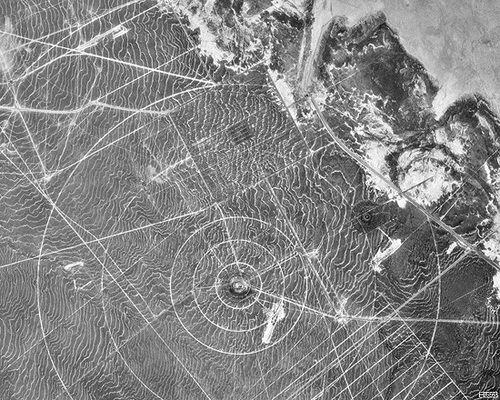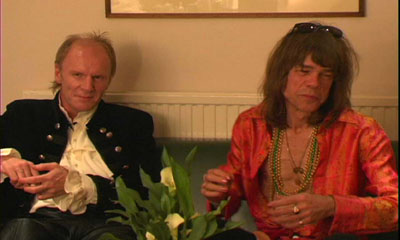I’m totally with her on the Calypso Hamptons hegemony, but for someone with spreads in Southampton and Montana [or is it Wyoming? or both?], Alex Kuczynski sure spends a lot of time thinking about Pottery Barn.
In the Sort-of Ethnic Home [nyt]
Bloghdad.com/Really??
First, I’m trying to imagine what kind of fundraiser one would find both David O. Russell and George W. Bush. But allowing for that possibility, I have to say I was surprised to hear this anecdote:
[Three Kings] director Russell ran into candidate George W. Bush at a Hollywood fundraiser in the summer of 1999 and told him that he was making a movie critical of his father’s Gulf War legacy. “Then I guess I’m going to have to go finish the job, aren’t I?” the younger Bush replied.
From J. Hoberman’s review of Jarhead in the Village Voice
According to an LA City Beat interview last year around the time of I Heart Huckabees, Russell met GWB at Terry Semel’s house in July 1999. DOR called Semel “an opportunist who was jumping off Clinton and onto the Bush bandwagon at the time.” Of course, now we call him the CEO of Yahoo.
The World, Chico, And Ever’thin’s Innit
Jia Zhangke’s Unknown Pleasures was eye-opening, the tale of two disaffected slackers told in a Chinese-inflected, naturalist style.
Now Jia has turned his eye on a symbol-soaked Chinese theme park full of miniature world landmarks, which provides the impossibly contrived backdrop for an unassuming, bleak narrative. Roger Ebert loves it.
The World, dir. by Jia Zhangke [ebert via archinect]
Speculating On The Absence Of Malick
Caryn James acknowledges that talking about Terrence Malick’s career involves a lot of speculation–before she proceeds to speculate on his “20 year absence” from filmmaking:
Logic and cheap psychology suggest that fear of success or fear of failure might be involved. He may never duplicate the artistry and acclaim of his early films, and it wouldn’t be surprising if the prospect of competing with himself caused creative paralysis in a filmmaker who likes every blade of grass to be shot perfectly.
Whatever. With the man’s next movie, The New World, supposedly set to debut this Christmas, you can’t help but write about him. I can totally appreciate that.
The Enigmatic Malick Is Back [nyt via iht]
Digging Dugway

Whoa. The Dugway Proving Ground is in Skull Valley, an hour and a half west of Salt Lake City. It’s where the US Army tests chemical and biological weapons and defense systems. It’s the site of an incineration program for the US’s stockpiles of bio/chem weapons. And it’s probably the greatest piece of Earth Art since the Nazca Lines.

The DoD’s alterations of the landscape–seen here in Terraserver photographs–rival the Spiral Jetty, Double Negative, Roden Crater, even, in both aesthetic power and content. Flash forward a few hundred years and ask yourself, which desert markmaking will have the most to say about the mid-20th century?
Dugway’s been dealt out of the Earth Art discussion because it’s a) functional, and b) institutional, not individual, but those seem like quaint technicalities. What if the only reason they’re not considered art–or considered alongside art, at least–is that no one’s really had access to them?
Dugway Proving Ground [pruned, via tropolism]
previously: earth art via satellite
N.Y. Doll Revelations
Stuart, our man in Los Angeles, files this report from a KCRW-sponsored screening of N.Y. Doll last weekend where director Greg Whiteley and his producers Ed Cunningham and Seth Lewis Gordon, discussed making the film:
Greg had known Arthur had been in a band as another church member had told him, but the film really started when Arthur told Greg that he had an email that his band was reforming. The first piece filmed was the recovery of the bass guitar from the pawn shop as he had to practice.
The producer also talked interestingly about the way that Arthur’s voice changes through the filming from rather stumbling speech patterns early to the rather stirring and dramatic prayer at the end.
The Morrissey part was filmed and edited in after the Sundance festival so it has a changed tone now. [And it’s pretty clear that all the celebrity interviews were grabbed in one shot at the Meltdown Festival. In the production notes, Whiteley talks about never having permission to do anything, just going as far as their “Killer has a posse” stance would take them.]
It is also never quite clear, and Greg said this as well, whether
Arthur was expected to be part of the reunion, as he found out almost by mistake. Obviously his fan club had an email for him, and Greg said that Sylvain probably met Arthur about once a year on his annual tours, so he knew he was available/alive.
They do briefly mention [Kane & Johansen] last being together shouting at each other in a trailer park in Florida but nothing more than that. I get the feeling there is a great “New York Dolls” documentary waiting to be made. The Ramones doc was ultimately depressing after seeing these people just beaten down trying to get a big enough audience for their music. [Yeah, does anything good ever come from Florida trailer parks? And the Dolls seemed to drop with predictably Spinal-Tappian frequency, too; not so feel-good.]
I thought Johansen’s entrance to the practice area with another video
behind him a day late in the middle of a song rather stagey but Kane seemed genuinely pleased to see him. Also what was the idea
behind only having less than 7 days rehearsal before flying and doing the gig? that almost seemed set up for failure.
Most of the stage footage is from a second show where he is
wearing the spotted shirt with the “diamante tie”; very few shots from
the first show, with the white shirt.
Johansen recorded 2 Mormon psalms, and Greg hoped they would both be on the dvd release.
The DVD is in my prayers. Bless you, Brother Stuart.
Previously: NY Doll – The greg.org review
Star Wars: Full Of Cremaster-y Goodness
When watched together, in sequence, Film professor Aidan Wasley says, the Star Wars 6-ilogy is actually revealed to be the world’s greatest art film, ever:
Star Wars, at its secret, spiky intellectual heart, has more in common with films like Peter Greenaway’s Prospero’s Books or even Matthew Barney’s The Cremaster Cycle than with the countless cartoon blockbusters it spawned. Greenaway and Barney take the construction of their own work as a principal artistic subject, and Lucas does, too.
Wasley goes on to talk about Lucas’s interest in both the “never in a bajillion years long, long time” narrative coincidences which make up the films; and the deterministic, aesthetic order that is required for the thousands of CGI scenes.
So you mean the stilted storytelling and embarassing acting is good because Lucas intended it that way? I think that by defining “art films” as the uncompromised vision of a single individual–who we’ll call an artist–then yes, Cremaster and Star Wars are both art films. But don’t expect critical or audience opinion to be swayed by someone re-ascribing a whole host of a film’s shortcomings as the artist’s intention.
There’s as much risk of turning out a dud from this kind of mythic, singular, lone artist process as there is from the much more maligned studio-meddling/compromising hack process. Think Gangs of New York, Baseketball and Team America World Police.
Star Wars: Episodes I-VI, The greatest postmodern art film ever. [slate via kottke]
Previously: On watching Cremaster 1-5 in order
Nicholson In, On Antonioni
On the occasion of the theatrical re-release of Michelangelo Antonioni’s classic film, The Passenger, its owner and star lead actor Jack Nicholson reminisces about working with his mentor.
It kills me that this is all we get from a 90 minute interview, though.
Nicholson resurrects `Passenger’ [lat/chitrib via robotwisdom]
Manohla Dargis’s article still packs more punch, I think: “Antonioni’s Characters Escape Into Ambiguity and Live (Your View Here) Ever After” [nyt]
NY Doll: A Documentary By The Book (Of Mormon)

There was a Church film in the 70’s that showed what happens when you don’t do your home teaching. Mike Farrell (the BJ-Hunniccutt-on-M*A*S*H guy) played an auto mechanic/Mormon bishop, who asks a young, career-focused lawyer in his congregation to be a home teacher to a troubled family where the father was becoming less active in the Church. Time goes by, the lawyer’s busy and can’t ever find the time to visit the family each month and check in on their spiritual well-being. One evening, he gets a distraught phone call from Sister Brown: her husband’s gone, fed up, the last straw, and now they’re getting a divorce. “Is there anything I can do to help?” the lawyer asks, which sets the wife up to drive the film’s message home: “There was probably a time when you could have done something, but now it’s too late.”
Greg Whiteley’s first film, N.Y. Doll, on the other hand, is a testament to the blessings that can come from doing your home teaching. Not only does your home teachee get his band back together after 30 years, your first film gets a raucous reception at Sundance.
When Whiteley was assigned to be fellow Los Angeles ward member Arthur Kane’s home teacher, all he really knew was that the middle-aged Kane was a quiet, seemingly rootless reformed alcoholic who’d been in a band as a kid, long before he joined the Church.
Typically, home teaching takes the form of short, friendly, monthly visits, where you read a verse or two, share a prepared inspirational message from church leaders, and ask, slightly awkwardly, “Is there anything we can do for you?” And every once in a while, you help someone move.
Arthur Kane’s home teachers, including Whiteley and the guy before him, who’s interviewed in the movie, clearly magnified their callings. They gave Arthur money to get his prized bass guitar out of hock. Whiteley started videotaping Kane, making him the star of a film which, at the time, had no story and no prospects; all the big, archetypal plotpoints that occur in NY Doll–the Dolls reunion, the intervention of Morrissey, Kane’s illness–only happened after filming had begun.
[At least that’s how it appears. Most of the footage in the film appears to have been shot in small, intense bursts, even single sittings: Kane on the bus, at the Family History Center, the NYC reunion/rehearsal, picking up all the rock legend interviews backstage at the Meltdown 2004 performance in London. It’s entirely possible that N.Y. Doll started out as a favor from a filmmaker, to help a friend tape his conversion story and his colorful personal history.]
In any case, NY Doll deftly and sensitively navigates two, even three paths as it tells Kane’s tale: there’s the VH1-style “where are they now?”/reunion rockumentary; the tearjerking, feel-good “grant a wish” by-the-book PBS special; and–and I don’t imagine many people, Mormon or not, will spot this–a matter-of-fact lesson in the exercise of religious faith.
While the NY preview audience [heathen journalists all] I saw the film with tittered at the mention of answered prayers, miracles, and Kane’s explanation of how the Holy Spirit revealed The Book of Mormon’s truthfulness to him [“it’s like an acid trip from the Lord”], that kind of experience and language will seem utterly commonplace to LDS audiences. So much so, that it may go unnoticed; but Whiteley’s ability to document LDS religious doctrine and sentiment without resorting to either media-outsidery cynicism or church-insidery didacticism is such a rare achievement, I’m tempted to call it a miracle. He that hath ears, let him hear, I guess.

The film’s arcs aren’t perfect, however, just the best they got on tape; I would have liked some more from Kane on the breakup and supposed bad blood that kept him and Doll lead singer David Johansen apart for 30 years. This reconciliation/making amends thread is pegged by his bishop–and by Kane himself–as the real dream-come-true; it’s the “right” answer, Jesus-wise, but in retrospect, it didn’t feel supported by the reunion buildup. And Kane’s Family History Center co-workers could have been a little less cute-ified [“Q: you could be groupies! A: hee hee”]. But these are quibbles, really.
The moments of real emotion that Kane fans like Bob Geldof, Morrissey, and that one critic chick…sorry, Love…evince, and the patience/tolerance/goodwill/what-have-you when Kane leads the band in a pre-performance prayer are incredibly touching. Especially considering how obviously out of touch Kane could be [his Joseph Smith-inspired stage costume was called a pirate outfit by one person backstage]. If anyone spoke ill of his subject, Whiteley’s heart was too full of charity to include it.
In the production notes, the filmmakers asked reviewers not to talk about the ending, so instead, I’ll talk about the end of the ending credits. That is where I and one other guy who stayed were rewarded with one of the most inspired musical mashups ever: an unplugged rendition of the archetypal Mormon hymn, the dirge-like “A Poor Wayfaring Man Of Grief,”–a favorite of both Kane and Joseph Smith–sung by NY Doll David Johansen in his hard-lifeworn, gravelly, and heartfelt voice. It’s no cover of the Nine Inch Nails’ “Hurt,” but don’t we all fall short of the glory of Johnny Cash?
It’s a generous gift from Johansen to his once-estranged bandmate, all the more so because it’s so utterly unexpected. This is one pearl of great price that I hope someone will rip and get into wider circulation immediately.
N.Y. Doll opens today in New York (at the Angelika) and Los Angeles. See the New York Doll website for more info and release schedules. [newyorkdollmovie.com]
Is There Life After Rock ‘n’ Roll? [stephen holden’s nyt review]
previously: Oh My Heck! Brother Greg Whiteley’s NY Doll
Kubrick’s Lost 2001 Talking Head Prologue
To differentiate 2001 from the “flying saucer pictures” that owned the sci-fi genre at the time, Stanley Kubrick planned to begin the movie by showing interviews with 21 real-world scientists about their predictions for the future and the likelihood of extra-terrestrial life.
This prologue was dropped for length, and the footage has yet to be located, but recently discovered transcripts of the interviews will be published next month in the UK. The Independent reports that Carl Sagan was on the list to be interviewed, but was cut when he demanded editorial control and a percentage of the gross. millions and millions.
2001: The secrets of Kubrick’s classic [independent.co.uk via…um]
Are We Alone?: The Stanley Kubrick Extraterrestrial Intelligence Interviews [amazon.co.uk]
And Nancy Swats His Pesky Little Hand Away

In his efforts to duplicate Ronald Reagan’s political career, he forgot one crucial lesson: watch your back around Nancy.
Here’s a paragraph from Elizabeth Bumiller’s NYT story, “At California Ceremony, Bush Reaches for Reagan Mantle”:
Laura Bush and Nancy Reagan were at the president’s side for the dedication. In brief remarks before he spoke, Mrs. Reagan recalled that on her husband’s last flight on Air Force One, home to California, his staff poured Champagne and shouted, “Mission accomplished, Mr. President!” On Friday those words seemed an echo of Mr. Bush’s own “mission accomplished” moment, now regretted by his aides, in which a banner with that message hung above him on the aircraft carrier Abraham Lincoln when, in May 2003, he declared major military operations in Iraq at an end.
Suddenly, the Bush banner takes on a whole new dimension which I’ve never seen discussed anywhere. [This, I think, would be the time to confess I’ve never read Reagan’s autobiography.]
Reagan chose his “Mission accomplished” anecdote as the cinematic ending for his book, for which he clearly envisioned a sequel: “Finally, champagne was poured and glasses were raised. ‘Mission accomplished, Mr. President,’ someone called out, ‘mission accomplished.’ Not yet, I thought to myself, not yet. …” The Reagan faithful would’ve recognized Bush’s 2003 banner as a direct reponse–a “now, at last”–to their Great Leader’s call. To which Nancy replies, “I don’t think so.”
Previously: Sforzian Backstabbing
John Cage On WPS1 (And On Their Blogs)
For the 1993 Venice Biennale, PS1 produced an exhibition of and about John Cage’s work calledIl Suono rapido delle cose. This week, WPS1 has added a webcast of the accompanying CD to their archive. The CD features performances by Lee Ranaldo, John Zorn, David Byrne, Joey Ramone, among many others, interspersed among Cage reading his own stuff. Definitely worth checking out. [warning: don’t expect any babies to sleep through Ranaldo’s jarring chords.]
Meanwhile, the Cageian embrace of randomness is alive and well on WPS1’s blogs [who knew?]. It seems there are 13 feeds-in-one, although not all have been kept up to date. Upbeat updates from one blogger’s happy Scandinavian/Los Angeleno curatorial collaboration called Civic Matters are interlaced with another blogger/dj’s virtual spitting on Rehnquist’s grave. It may be a perfect embodiment of the WTF-chaos that gives PS1 its edge.
2005-10-24, This Week In The New Yorker
![]()
Issue of 2005-10-24
Posted 2005-10-17
THE TALK OF THE TOWN
COMMENT/ GAME PLAN/ George Packer on what the Republicans’ troubles mean for the opposition.
NOSEBLEED DEPT./ RARE AIR/ Nick Paumgarten visits an office with altitude.
WHO R U?/ HARRIET 4 JUSTICE/ Mark Singer trades thoughts with Harriet Miers’s alter ego.
GOOD WORKS/ BED BATH & BOWERY/ Lauren Collins on the best-friend benefactors of the New Museum.
EVERYBODY’S AN EXPERT/ DRAWING PITCHERS/ Michael Rosenwald on an illustrator with a secret.
SHOUTS & MURMURS/ Bruce McCall/ Only cronies need apply.
THE CRITICS
BOOKS/ Jill Lepore/ People Power/ Revisiting the origins of American democracy.
BOOKS/ H. Allen Orr/ Turned On/ A revolution in the field of evolution?
ON TELEVISION/ Nancy Franklin/ Big Mac/ At long last, a woman in the White House.
MUSICAL EVENTS/ Alex Ross/ Fresh Faces/ City Opera’s fall season.
DANCING/ Joan Acocella/ Paper Tiger/ Michael Flatley in a new step-dancing extravaganza.
THE CURRENT CINEMA/ David Denby/ Family Matters/ “The Squid and the Whale” and “Elizabethtown.”
FROM THE ARCHIVE
http://www.newyorker.com/fact/content/articles/050228fa_fact1″>A REPORTER AT LARGE/ Michael Specter/ NATURE’S BIOTERRORIST/ Is there any way to prevent a deadly avian-flu pandemic?/ Issue of 2005-02-28
One week of The New Yorker not enough for you? How about 80 years worth? Buy The Complete New Yorker, an 8 DVD-ROM set and companion book complete with every page of the magazine, ever, through last September, at Amazon.
On A Complex Relationship With The Dry Cleaners

It’s the kind of thing you’d expect, sadly, of a clothes horse in a bubble economy: he buys a the turquoise-est, maroon-est, and black-est striped Yohji Yamamoto shirt he can find. That it cost $675 in 1999 is no surprise. That it’s made of 100% polyester of the kind that litters mid-western thrift shops also raises no eyebrows.
He he wears it proudly on the flight to Salt Lake City to spend that post-IPO Christmas with his family. Somehow, he loves this shirt, even the second when he steps off the plane and realizes that it is his oh-so-Grand Street purchase that has, in fact, returned home; it turns out to be oh-so-indistinguishable from every potbelly-filled, cotton twill, line dancing rodeo shirt coming at him on the concourse. There had been nothing else like it in SoHo, but context was all.
“Dry Clean Only,” the label said, and that’s what he did, religiously. He respects the dry cleaner, cowers a bit, even. Does what he’s told. You want your $675 shirt ruined by your own cheap laziness? I didn’t think so.
It’s 2005, a late autumn night on the road. Sweat’s built up on his shirt–it’s one of two in his bag–but there’s no dry cleaners, and no time to wait until Thursday after 3:00 for pickup even if there was. What to do? He takes a chance and throws the shirt in with the rest of the laundry. It’s late, one mixed load. He’ll take it out to air dry, anyway, how bad could it be? Besides, it’s been months since he’s cleaned the damn thing, late winter/early spring, anyway, before he had to abandon it for the humidifying summer.
The shirt comes out barely wet, safe, fresh, perfect. Nearly as soft as those cashmere sweaters the first time he machine washed them on the advice of the 85-year-old knitter for Vogue Knitting, who, he figured, oughta know. And to think that all these years, he’d been so needlessly cautious sending it to the dry cleaners. All that money, that time, that waiting, that inconvenience, that dependence, for what?
It’s only well into the next day when he remembers he’s made a movie about a dry cleaners, his grandfather’s old dry cleaners, in Utah. The kind of small town place where rodeo shirts get a pressing before the big dance, and where bootcut jeans get a crease so sharp and starch so heavy they don’t hang, but arc like rainbows on the hanger. Is some familial longing somehow transmuted into his reverent care of a shirt? Or has his ironed-on faith in dry cleaning’s infallibility finally started to crack and fade? After waiting decades to buy his own brand of toothpaste, has the man finally broken another enviro-genetically imposed bond?
The euphoria of suddenly discovered self-suffiency hasn’t worn off yet, and until that flares down it’s really too hard to say.
Get A Grip
You can fake the accent, you can fake the peppy talks with the troops [oh, actually, you can’t fake those anymore, sorry], and when it’s off-camera, you can fake being a rancher. But what you can’t fake, turns out, is looking like you’ve ever hammered a damn thing in your life.
The problem here is the same as it’s always been: too many conflicting backstories for the character either muddles the plot along the way, or it mucks up the ending [guess which one we’re at now]. The jus’folks ever’man-o-God vs the “happy bottom quartile” Andover/Yale legacy vs the HBS Big Picture CEO President who supposedly picks the most talented people around and doesn’t sweat the small stuff.
Well, you should’ve had a grip build this set, GWB, because as David Letterman points out, you hammer “like a little girl.”
Choking The Hammer (not Tom DeLay, sorry) [onegoodmove.com, video via robotwisdom]
